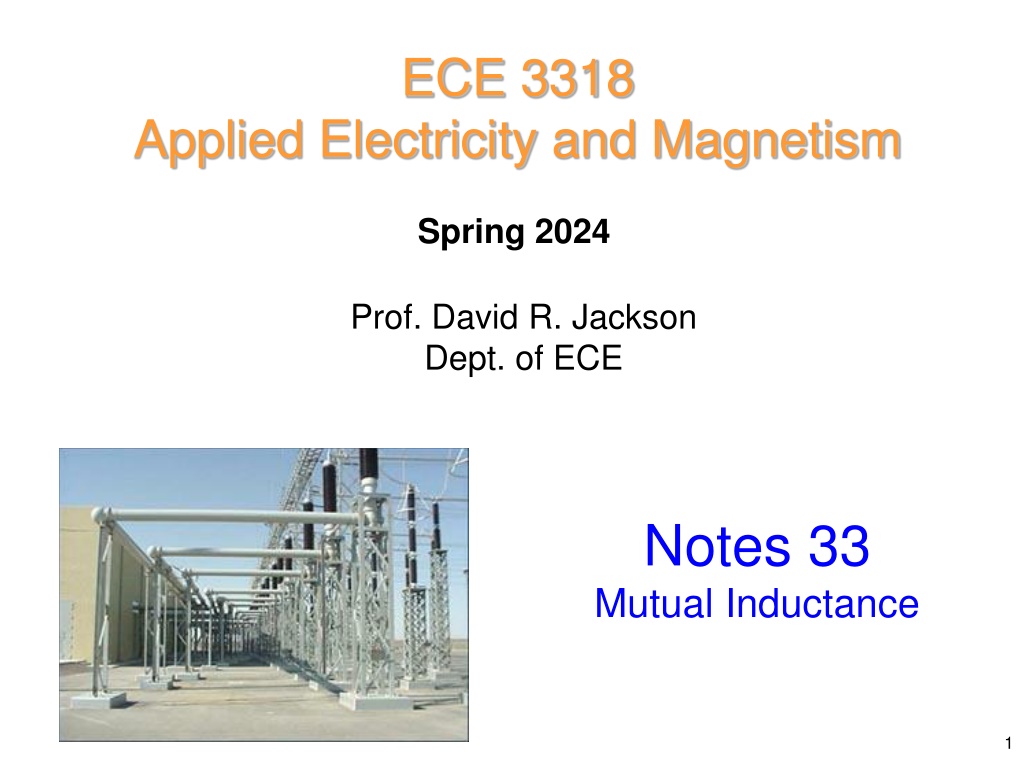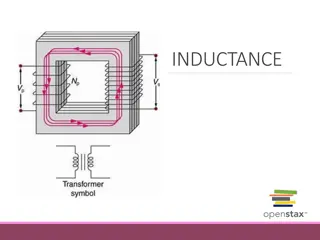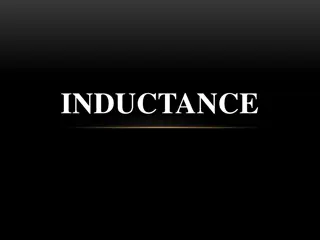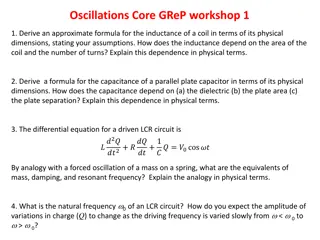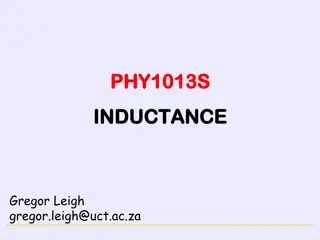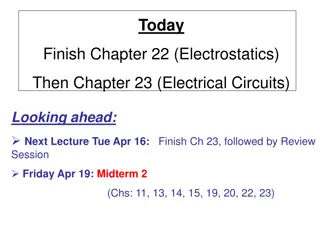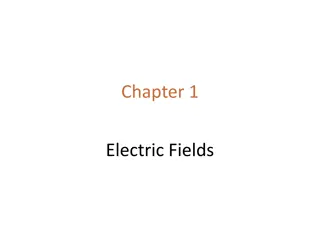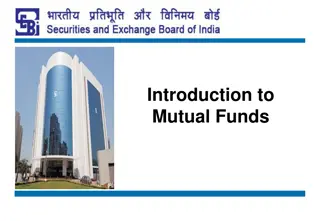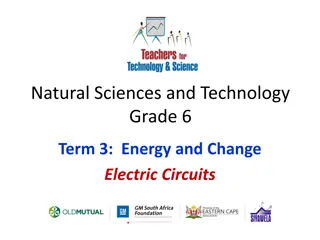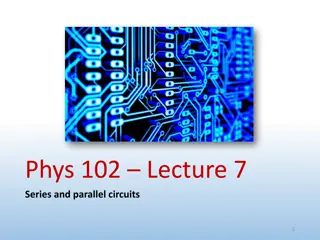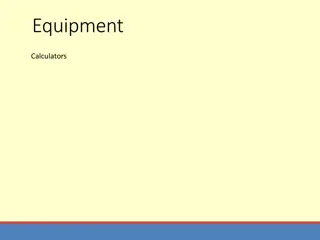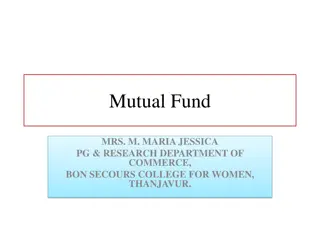Understanding Mutual Inductance in Electric Circuits
Exploring the concept of mutual inductance between coils, this content delves into the relationship between current flow, magnetic fields, and the generation of induced voltages. It explains the calculations, properties, and circuit laws associated with mutual inductance in a clear and informative manner. The examples provided demonstrate how to determine mutual inductance values, highlighting the importance of proper orientation and understanding of magnetic flux.
Download Presentation

Please find below an Image/Link to download the presentation.
The content on the website is provided AS IS for your information and personal use only. It may not be sold, licensed, or shared on other websites without obtaining consent from the author. Download presentation by click this link. If you encounter any issues during the download, it is possible that the publisher has removed the file from their server.
E N D
Presentation Transcript
ECE 3318 Applied Electricity and Magnetism Spring 2024 Prof. David R. Jackson Dept. of ECE Notes 33 Mutual Inductance 1
Mutual Inductance 2 n 1 n 2I 1I Two coils are in proximity of each other. Note: Each coil has a set of output terminals, but this is not shown. Current reference directions and unit normal vectors are defined on both coils. (The unit normal vectors are each determined from the corresponding current reference directions, by the right-hand rule for inductor flux.) Reminder: Right-hand rule for inductor flux: Fingers are in the direction of the current I in the coil, and the thumb gives the direction of the unit normal (the reference direction for the flux). 2
Mutual Inductance (cont.) M 1 n 2 n 21 1I 21 B n dS 2 Coil 1 is energized Coil 2 is left open-circuited Meaning of subscripts: the flux through coil 2 due to coil 1 1 21 S 2 These two numbers go together. M 21 Define mutual inductance: 21 I 1 N In general, if coil 2 has multiple turns: Note: = M 21 2 I 21 For the figure shown, 21<0 if I1 > 0. Hence, M21< 0. 21 I 1 1 3
Mutual Inductance (cont.) 1 n 2 n M 12 2I 12 = 1 n dS B Coil 2 is energized Coil 1 is left open-circuited Meaning of subscripts: the flux through coil 1 due to coil 2 2 12 S 1 These two numbers go together. M 12 Define mutual inductance: 12 I 2 N Note: In general, if coil 1 has multiple turns: = M 12 1 I 12 For the figure shown, 12<0 if I2 > 0. Hence, M12< 0. 12 I 2 2 4
Mutual Inductance (cont.) A general property (proof omitted) is that both mutual inductance components are always equal: = = M M M 12 21 Note: The units of M are Henrys. 5
Circuit Law for Coupled Coils Total flux through coil 1: Total flux through coil 2: di dt di dt di dt di dt = + = + = v L 1 M 2 = = + + 1 11 12 1 1 12 2 22 21 + Li M i L i M i 1 1 12 2 2 2 21 1 = + v L 2 M 1 Faraday s law: Faraday s law: 2 2 21 d d = = v 1 v 2 1 2 dt dt M 21 1 n 2 L 2 n 1L Note: 2i We use passive sign convention on both coils. 1i 2v + - 1v + - 6
Example N R 2 N 2 1 R 1 r z sL = length r 1I FindM12 , M21 Right-hand rule for inductor flux: = = 2I n n z 1 2 For M12: N L H = 2 2 M N R 12 1 0 1 r y s N = = M 12 1 I 12 12 I z B 2 B 2 2 = = n dS B dS 1 R 2 12 1 2 z S S 1 1 x ( ) ( ) = = 2 2 B R H R 2 1 0 2 1 z r z N L )( ) ( ) ( = = 2 2 R 2 2 n I R I R 2 2 0 1 0 2 1 r r s 7
Example (cont.) N R 2 N 2 1 R 1 r z sL = length r 1I = = n n z 2I 1 2 For M21: N L H = 2 1 M N R 21 2 0 1 r y s N = = M 21 2 I 21 21 I Bz1 1 B n dS 1 ( ) ( ) = = = = 2 2 B dS B R H R 1 21 2 1 1 1 0 1 1 z z r z R1 R1 S S 2 2 N L )( ) ( ) x ( = = 2 2 1 1 n I R I R 1 0 1 0 1 1 r r s Note: R2 Bz1= 0 for > R1. 8
Example (cont.) N R 2 N 2 1 R 1 r z sL = length r 1I 2I Summary: N L = 2 2 M N R 12 1 0 1 r s N L = 2 1 M N R 21 2 0 1 r s 2 1 R L ) ( = = = M M M N N H 12 21 0 1 2 r s 9
Dot Convention The dot convention allows us to use mutual inductance M without having to visually inspect how the coils are wound. di dt di dt di dt di dt = + = + , v L M v L M 1 2 2 1 1 1 2 2 The dots tell us where to put the positive sign for the voltage on one coil, and where the current enters the other coil. Note: We also label voltages and currents with the passive sign convention, to be consistent with the self inductance. 10
Dot Convention (cont.) Here is one possible dot arrangement: ( ) 1i t Coil 2 + - ( ) 1v t M ( ) 2v t - + ( ) 2i t Coil 1 di dt di dt di dt di dt = + = + , v L M v L M 1 2 2 1 1 1 2 2 11
Dot Convention (cont.) Here is another possible dot arrangement: ( ) ( ) 2i t 1i t + + M Note: The M here is the negative of the M on the last slide (if the coils are the same). ( ) ( ) 2v t 1v t - - We can always choose the dots to make M positive if we wish. Coil 1 Coil 2 di dt di dt di dt di dt = + = + , v L M v L M 1 2 2 1 1 1 2 2 12
Example Write down KVL phasor-domain mesh-current equations to describe this circuit. Note: M could be either positive or negative. R 1L 2 M 2 L 1 R +- V Phasor voltage C C 1 2 13
Example (cont.) 1v 1L R 2 - + M 2v Inductor voltages + 2 L 1 R 2i 1i +- V Note: In these two equations the first minus sign is from the dot being on the opposite side from the + sign of the voltage drop on inductor 1. The second minus sign (the one on the current) is because we want the current going into the dot on inductor 2. - C C 1 2 ( ) ( ) d i d i di dt di dt = = 2 1 v L M v L M 1 2 1 1 2 2 dt dt Phasor domain = j L I + j MI = j L I + j MI V V 1 1 1 2 2 2 2 1 14
Example (cont.) 1 V KVL 1L R + - 2 - + M V 2 + - + - 2 L 1 R 2I 1I +- V - + - + - + - + C C 1 2 1 ( ) + j L I + j MI + + = 0 V R I I I 1 1 2 1 1 2 1 j C 1 1 ( ) + + j L I + j MI + = 0 R I I R I I 1 2 1 2 2 2 2 1 2 j C 2 15
